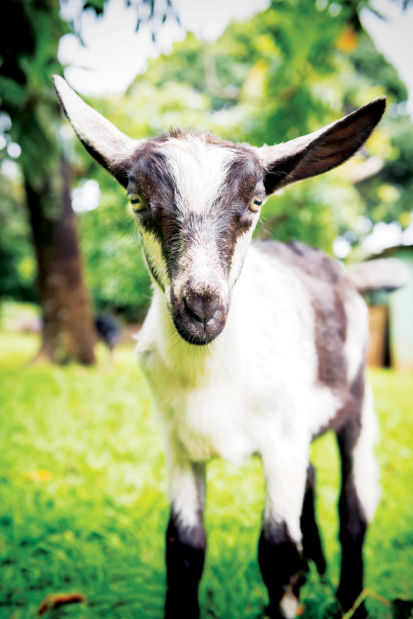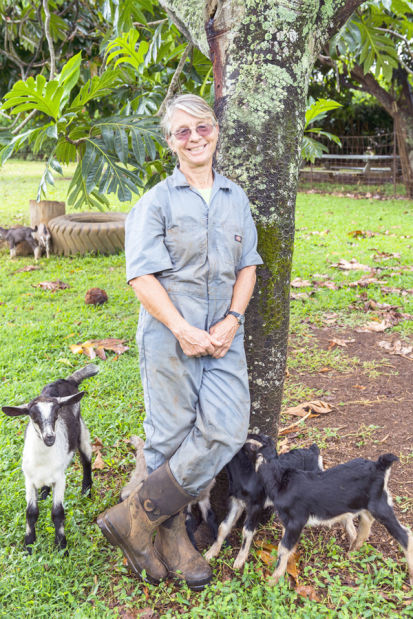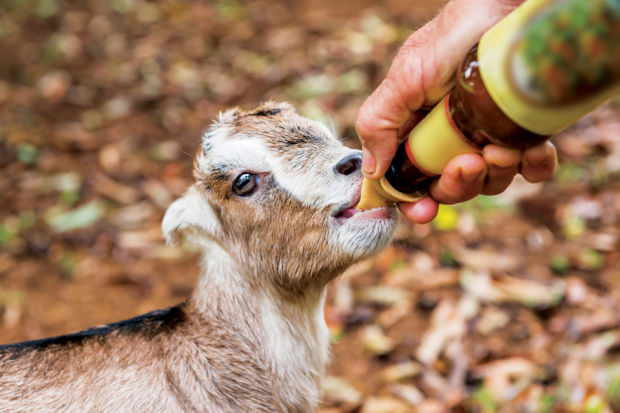Kauai Kunana Dairy is a USDA certified organic, Animal Welfare Approved dairy farm in Kilauea. About 80 goats graze on 24 acres of pasture and their milk is used to make chèvre and feta cheese as well as soap, hair
Kauai Kunana Dairy is a USDA certified organic, Animal Welfare Approved dairy farm in Kilauea. About 80 goats graze on 24 acres of pasture and their milk is used to make chèvre and feta cheese as well as soap, hair care, and skin care products. The dairy sells live goats in pairs ($100) and recently, they began selling chevon.
The Wooton family began farming on Kauai in 1979 and today they also grow and sell fruit and vegetables. Bob and Louisa’s son Ryan collects honey from hives on the farm and makes beeswax products such as soap, balms, salves and candles. With farm fresh produce, Ryan’s wife Sarah makes value added products such as soursop lime-aid, cookies and banana bread.
Chevon
Goat meat, known by the French name chevon, is eaten by more than 70 percent of the world’s population. Goat is thought to have been one of the earliest domesticated animals and cave art dating back 20,000 years indicates that they were common and important.
Today, chevon is a staple of Africa, Asia, South America and Central America and shows up in the food of the Middle East, India, Pakistan, Mexico, Caribbean, and Europe. In the United States, consuming goat meat is an increasing trend. From 1987 to January 2013, the number of meat goats on American farms rose from roughly 415,000 to 2.3 million. For more than 20 years, the central Texas town of Brady has staged the World Championship Barbeque Goat Cook-off on Labor Day weekend.
Kids are less than 12 months old and often slaughtered at 3 to 5 months, weighing 25 to 50 pounds. The taste of young goat meat, also called cabrito, has been described as clean, grassy and herbal. Even though the Wootons love their kids like their kids, Louisa says they have to be pragmatic and practical.
“In order to run a dairy, you have to breed your goats,” she explains. “The goats don’t give milk unless they have babies.”
The Wootons are turning a byproduct into a primary product, and avoiding selling them on the hoof, where they have no control over handling and slaughter.
“The best we can do is make their life good while they’re here and handle the meat goat better than anyone else does,” she says. “We are grateful to them because they are giving their lives so that we can eat.”
Season
In Hawaii, kidding season can start right around Christmas and can dribble on into June. The really busy time is usually February to May. Goats are diurnal breeders and do not come into heat until the days shorten in July and August.
What to look for
The best time to get young goat meat on Kauai is April through September. Kauai Kunana Dairy meat goats are processed at Andrade Slaughterhouse in Kalaheo, which is USDA certified and Animal Welfare Approved. One-quarter, one-half and full carcasses are sold for $6 a pound. One fully dressed carcass weighs about 30 pounds.
Preparation
Despite goat’s reputation for strong, gamey flavor, the taste is mild and flavorful if it’s raised and prepared properly. Chevon is lean, so low-heat and slow cooking insures succulence. Try stewing, braising, slow roasting, smoking or barbecuing for best results. It can also be made into sausage or jerky.
Southern Italians and Greeks serve roast chevon for Easter. Goat meat is an Easter staple in the alpine regions of central Europe, where they’re braised in Bavaria and breaded and fried in Tyrol.
Cabrito is a specialty in Mexican, Peruvian, Brazilian, and Argentine cuisine. It’s made with a kid that’s no more than forty-days-old and slow-roasted in an underground oven. In Hawaii, the underground oven is called imu and kalua literally means “to cook in an underground oven.”
Health benefits
Goat meat is low in fat, cholesterol, calories and saturated fat. It’s more than 50 percent lower in fat than American beef and is about 40 percent lower in saturated fat than skinless chicken.
Workshop
Goats provide meat, milk, weed management, fertilizer and companionship. If you’d like a pair, check out the workshop by Kauai Kunana Dairy and the University of Hawaii Corporative Extension Service Kauai County Livestock and Range Program. Learn about animal nutrition, grazing management, parasites, basic health care, breeding and more. The workshop is 9 a.m. to noon May 3 at the Kauai Agricultural Research Center in Wailua. Tickets are $5. Reservations can be made by calling 274-3472.
Kauai Kunana Dairy chevon can be found at restaurants: Hukilau Lanai, Merriman’s Fish House, Duke’s Canoe Club, The Garden Cafe and The Club at Kukuiula. For live goats or chevon orders, call Louisa at 828-0095.
• Marta Lane, a food writer on Kauai since 2010, offers farm to fork food tours and is the author of Tasting Kauai: Restaurants – From Food Trucks to Fine Dining, A Guide to Eating Well on the Garden Island. For more information, visit TastingKauai.com.
“Kunana Dairy chevon is popular when we feature it,” says Ron Miller, executive chef and owner of Hukilau Lanai. “It has such a clean flavor, unlike any goat I’ve ever tasted. Its mild flavor is similar to their goat cheese. Since we buy the whole animal we always have trimmings to use.”
This recipe is a collaboration between Ron Miller and Regie Anical.
2 pounds Kunana Dairy chevon
2 tablespoons dried Chinese black beans
2 tablespoons oyster sauce
1/4 cup mirin
1/4 cup onion, diced
1 tablespoon cilantro, chopped
1/4 teaspoon white pepper
1 egg
1/2 teaspoon salt
15 wonton wrappers
Cooking oil
Grind or finely dice goat meat. Measure all ingredients and mix by hand until well combined. Lay out 15 wonton wrappers and brush the edges with water. Place one tablespoon of the meat mixture on each. Fold the wrapper in half and pinch the edges closed.
Add one tablespoon of oil to a hot pan. Place 5 potstickers in the pan and cook until the bottoms of each are brown. Add 1/4 cup of water and cover pan with a lid. This will create steam, which will finish cooking the potstickers. They are done when most of the water has evaporated, after about 3 to 4 minutes. Clean and re-oil the pan between batches. Serve immediately.
Caution: When adding water to the pan, steam may burn your hand if it’s too close.




